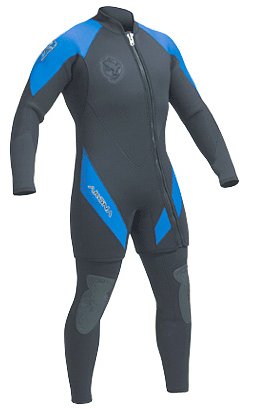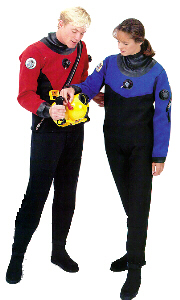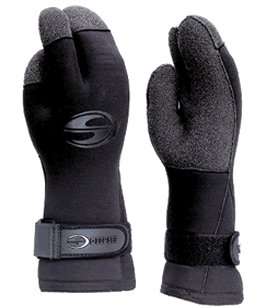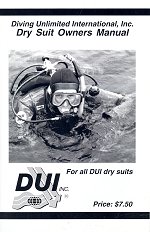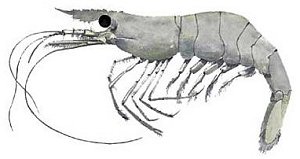Almost all diving activities, whether in the tropics or in colder waters, will require some sort of exposure suit. For local conditions, this means either a full heavy wetsuit or a drysuit. For the tropics, there are thinner wetsuits and fabric skins, but these are never warm enough for use around here. Water temperatures in the north Atlantic vary from just above freezing at depth during the coldest part of the year to the mid-seventies at the surface during the warmest. Typically, you can expect high-fifties to low-sixties at depth even over the summer.
Apart from protection from the cold, there is also a need for mechanical protection. Wherever you are diving, there are probably lots of sharp rusty edges, barnacle-covered rocks, old lost fishing lures and line, and miscellaneous junk, and that's not to mention critters that bite. Skin gets very soft in the water, and you can cut yourself badly just by grabbing something or bumping your head. In the tropics, sun protection in shallow water and on the surface is also a consideration.
Beginners generally start out with a wetsuit for several reasons. Foremost is cost. You can get into a good wetsuit for a fraction of what even a cheap drysuit costs. Familiarity is also a factor, since you probably got certified in a wetsuit, and by now you feel comfortable in one. Finally, wetsuits are perceived to be easier to use than drysuits. This is only partially true, and if this is your only reason for selecting a wetsuit over a drysuit, you are making a big mistake, and there is no reason not to start out with a drysuit instead.
With a wetsuit, you can expect to be diving in relative comfort around here from late June to October. Below 50 ft or so, I always feel cold in a wetsuit, no matter what time of year it is. With a drysuit, you can dive year-round in relative comfort. If you plan to dive a lot, the extra investment could be well worth it. You may never notice the difference between two different masks or two different regulators in the water, but you will always be acutely aware of the chilly discomfort if you make a bad selection in your exposure suit.
2016 Update
Where once DUI was the only real option for a drysuit, now many manufacturers have entered the market with equally good products, often at much more reasonable prices. Otherwise, rubber suits are still rubber suits.
The minimum exposure protection you should plan on for New Jersey diving is a full 6 or 7 mm neoprene wetsuit, with equivalent hood, gloves, and boots. A common misconception about wetsuits is that the water inside keeps you warm. This is absolutely false - the less cold water that gets in, the warmer you will be. ( Some folks actually bring jugs of hot water and pour it into their wetsuits just before the dive. ) Once the suit floods and the water inside warms up, you do feel better, but that water got warmer because you got colder. The trick is to keep as much as possible of this warmed water inside the suit, but almost every motion you make will pump out some warm water, and bring in more cold.
Two things will reduce this pumping tendency. The first thing is a properly sized and fitted suit. A wetsuit should be snug, without crushing you, and there should be no large empty spaces inside when you put it on. Many people have a hard time finding a wetsuit that fits just right. The second thing is a well-made suit. Features of a superior wetsuit include:
More: Exposure Suits - Wetsuits ...
Serious New Jersey divers wear drysuits. A drysuit is a waterproof suit with built-in feet that seals around your neck and wrists ( some have built-in water-tight gloves and/or hoods as well, ) and a waterproof zipper to close it up. The idea is that although you are underwater, you don't get wet, but this is not entirely true. No seal is perfect, and certain actions will let small amounts of water leak in past the seals. However, most of the moisture that accumulates in a drysuit comes from its occupant, in the form of perspiration. If water can't get in, then it can't get out either. Perhaps these should be called dampsuits instead of drysuits.
Still, in cold water, a drysuit is much warmer than a wetsuit. This is because you maintain a constant layer of air between you and the cold, and air is an excellent insulator. While air is also the insulating factor in wetsuits, there is a difference. With either suit, the volume of air, and therefore the amount of insulation, compresses as you go deeper. With a wetsuit, there is nothing you can do about this, but with a drysuit, simply tap the inlet valve, and compressed air will flow from your tank into the suit, and puff it up again, keeping you warm. An added benefit is that by keeping the suit inflated to a constant volume, you maintain constant buoyancy, from the surface to the bottom, which can actually reduce the amount of lead you need to carry. Some divers even dispense with the BCD, considering that a drysuit can be thought of as a full-body BCD, but this is not recommended, and it is convenient to use the BCD as a quick trimming device and for surface flotation.
More: Exposure Suits - Drysuits ...
Diving gloves should be close-fitting, with long, gusseted, zippered, or Velcro gauntlets that overlap your suit sleeves. This is especially important with a drysuit, since the glove will protect the delicate wrist seal on the suit. Thin tropical gloves are of very limited use in the north - your gloves should be at least 5mm thick. Three-fingered mitts are much warmer than five-fingered gloves and are really not much clumsier. They are also much easier to get on and off, which makes me wonder why so few people use them. A little spray soap will make any glove easier to get on.
A hood is critical for maintaining warmth in the water. A good hood will be as close-fitting as possible, and have a generous collar for tucking into your wetsuit, thin skin-in seal around the face, and baffled vents in the top to release bubbles. A neck skirt is much less necessary with a drysuit, but it is a simple matter to cut one off if you don't like it. A neoprene cold-water hood should be at least 5-6mm thick.
The face-hole of a hood should be as small as possible - there is no reason to expose any skin here. The face seal of the hood should overlap your mask skirt, with just barely enough room below for your regulator. You can always trim out a too-small face-hole, but a too-big one pretty much negates any other good qualities a hood may have. Ideally, with mask and hood on, you should expose a small patch on each cheek, and no more.
More: Hood, Gloves & Boots ...
The heavyweight cold-water wetsuit is probably responsible for the premature demise of more nascent diving careers than any other factor. These awful things are simply uncomfortable and ineffective. For all the stiffness, squeezing, bulk, and extra weight of 5-7mm wetsuit, in the end, it really doesn't keep you warm, and most cold-water wetsuit divers are pretty miserable creatures. I have seen the constriction and topside overheating of one of these things make its poor wearer sick on dry land, never mind on a boat out at sea.
For an excellent guide to drysuit use, pick up a copy of DUI's drysuit owner's manual, available at most dealers for under $10.
Or just download it.
The argument that heavy cold-water wetsuits are easier to use is patently false. A wetsuit has a mind of its own and will make wide depth-dependant swings in buoyancy over which the wearer has no control. How is that better than a drysuit, which the user can consciously trim for constant buoyancy during the descent, and which semi-automatically trims itself during ascent?
More: Exposure Suits - Recommendations ...

